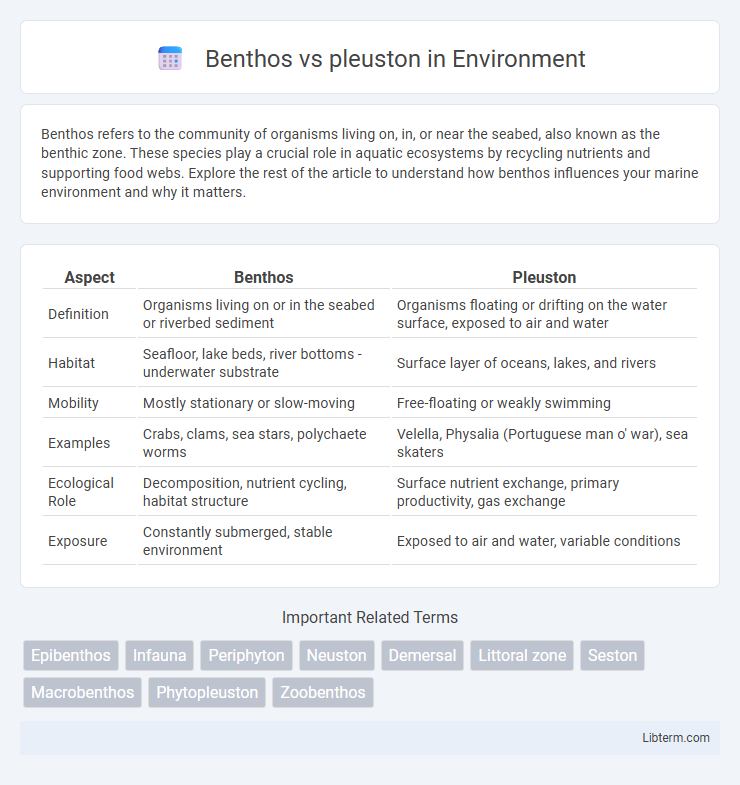Benthos refers to the community of organisms living on, in, or near the seabed, also known as the benthic zone. These species play a crucial role in aquatic ecosystems by recycling nutrients and supporting food webs. Explore the rest of the article to understand how benthos influences your marine environment and why it matters.
Table of Comparison
| Aspect | Benthos | Pleuston |
|---|---|---|
| Definition | Organisms living on or in the seabed or riverbed sediment | Organisms floating or drifting on the water surface, exposed to air and water |
| Habitat | Seafloor, lake beds, river bottoms - underwater substrate | Surface layer of oceans, lakes, and rivers |
| Mobility | Mostly stationary or slow-moving | Free-floating or weakly swimming |
| Examples | Crabs, clams, sea stars, polychaete worms | Velella, Physalia (Portuguese man o' war), sea skaters |
| Ecological Role | Decomposition, nutrient cycling, habitat structure | Surface nutrient exchange, primary productivity, gas exchange |
| Exposure | Constantly submerged, stable environment | Exposed to air and water, variable conditions |
Introduction to Aquatic Life: Benthos and Pleuston
Benthos refers to organisms living on or in the bottom sediments of aquatic environments, including diverse species such as crustaceans, mollusks, and worms. Pleuston consists of organisms inhabiting the surface layer of water, often floating or partially submerged, like water striders and certain algae. Understanding the distinct ecological roles and adaptations of benthic and pleustonic communities is crucial for studying aquatic ecosystems and biodiversity.
Defining Benthos: Life on the Bottom
Benthos refers to organisms that inhabit the bottom of aquatic environments, including oceans, seas, lakes, and rivers, residing on or within the sediment. These benthic species range from microorganisms and invertebrates like mollusks and crustaceans to larger animals such as starfish and certain fish species adapted to life on the seafloor. Unlike pleuston, which live at the air-water interface, benthos are adapted to conditions of low light, high pressure, and varied substrate types found on the bottom.
Understanding Pleuston: Surface Dwellers
Pleuston are unique surface dwellers inhabiting the air-water interface, distinct from benthos that live on or in the seabed. These organisms, including certain algae, insects, and cnidarians, exploit the surface tension to access both aerial and aquatic resources. Understanding pleuston ecology provides insight into their role in nutrient cycling and as a critical link in aquatic food webs.
Key Differences: Habitat and Adaptations
Benthos organisms inhabit the bottom of aquatic environments, such as ocean floors, rivers, and lakes, and exhibit adaptations like strong attachment structures, sediment burrowing, and tolerance to low light and pressure variations. Pleuston are surface-dwelling organisms living at the air-water interface, showing adaptations like hydrophobic surfaces, air-trapping mechanisms, and buoyant bodies to remain afloat and exploit surface tension. These key habitat differences drive distinct morphological and physiological adaptations that suit benthic organisms for substrate interaction and pleustonic species for surface mobility and gas exchange.
Examples of Benthos Species
Benthos species include organisms like crabs, sea stars, clams, and polychaete worms that live on or within the seabed. These benthic creatures play a crucial role in nutrient cycling and sediment stability in marine ecosystems. In contrast, pleuston species such as Velella and Physalia float at the water surface, relying on wind and currents for movement.
Notable Pleuston Organisms
Notable pleuston organisms include Velella, Physalia (Portuguese man o' war), and Janthina snails, which inhabit the air-water interface of the ocean surface. These organisms rely on the unique properties of the neuston layer, displaying adaptations such as gas-filled floats and vivid pigmentation for buoyancy and protection. In contrast, benthos organisms live on or near the seabed, exhibiting different ecological roles and physiological traits compared to pleuston species.
Ecological Roles of Benthos
Benthos, organisms living on or in the seabed, play crucial ecological roles by recycling nutrients, breaking down organic matter, and supporting food webs through their interactions with sediment and water. They facilitate sediment stabilization and bioturbation, which enhances oxygen penetration and promotes habitat diversity for various marine species. Benthos serves as a vital energy source for higher trophic levels, linking benthic and pelagic ecosystems.
Environmental Significance of Pleuston
Pleuston, comprising organisms living at the air-water interface, plays a critical role in global biogeochemical cycles by facilitating gas exchange and serving as a primary habitat for various marine species. Unlike benthos, which inhabit the seafloor and contribute mostly to sediment nutrient recycling, pleuston influence the atmospheric carbon cycle and support surface-level food webs crucial for aquatic biodiversity. Their ecological significance includes promoting primary productivity and acting as indicators of environmental change in marine ecosystems.
Threats and Conservation Challenges
Benthos and pleuston face distinct threats due to their different habitats, with benthic organisms endangered by habitat destruction from trawling, pollution, and ocean acidification, while pleuston species are threatened by surface pollutants like oil spills and plastic debris accumulation. Conservation challenges include insufficient monitoring of deep-sea benthic ecosystems and the difficulty of mitigating surface-level contamination affecting pleuston, compounded by the global scale of marine pollution and climate change impacts. Effective protection necessitates targeted marine protected areas, stricter pollution controls, and enhanced research to understand the ecological roles and vulnerabilities of both benthic and pleuston communities.
Benthos vs Pleuston: A Comparative Summary
Benthos refers to organisms living on or in the seabed, encompassing diverse species like crustaceans, mollusks, and seaweeds adapted to benthic zones with varying depths and substrates. Pleuston comprises surface-dwelling organisms inhabiting the air-water interface, including species such as water striders, Velella, and floating algae, adapted to superficial marine or freshwater environments. The key distinction lies in habitat depth, with benthos occupying bottom habitats and pleuston existing at the water surface, influencing their ecological roles, adaptations, and environmental interactions.
Benthos Infographic

 libterm.com
libterm.com